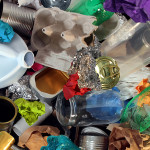
It took a long, long time, but curbside recycling has finally become commonplace in most U.S. communities. According to the U.S. Environmental Protection Agency, Americans create 251 million tons of waste every year.
We say that we “throw away” much of this waste, but of course, there is no away. Most of it (around 135 million tons) ends up buried in a landfill somewhere, where it takes centuries if not thousands of years to degrade, potentially leaching nasty chemicals into our soil and water supply.
Here’s the sad part: According to Keep America Beautiful, the recyclable materials in the U.S. waste stream would generate over $7 billion if they were recycled. That’s equivalent to Donald Trump’s net worth. In order to stop the flow of valuable materials to the landfill, we have to recycle.

If you’re a regular participant in your community’s recycling program, you’re probably feeling pretty pleased with yourself right now. Not so fast. In order to get the most out of these reusable waste materials, we not only have to recycle, we have to recycle properly. That’s right, there are rules to this recycling game, and unfortunately, many of us aren’t following them. Below is a list of common recycling mistakes, along with information about why it’s so important to get it right–for your recycler, your community and your world.
7 Recycling Mistakes You’re Probably Making
1. Separating (or not)—Is your recycling program single stream or dual-stream? Do you know the difference? Single stream recycling allows paper, cardboard, plastic, glass and metal to be mixed together for pickup. Dual stream recycling is also referred to as source separated recycling. This means keeping the fiber component—paper and cardboard—separate from containers, including glass and plastic containers and cans. There are pros and cons to both methods. But separating (if you don’t have to) or not separating (if you’re supposed to) just makes things more difficult for those on the other end of your recycling bin.
2. Including plastic bags—It is very rare for a local recycler to accept plastic bags. Plastic bag markets require that these materials be clean, dry and empty. Once they go in a recycling bin, they definitely do not meet the first two criteria. Solving this problem is easy: a) don’t use plastic bags and b) keep bags separate and return them to a local grocery store that accepts them for recycling (look for a bin near the front door).
3. Leaving lids on plastic containers—While an increasing number of plastics are now recyclable (you should still check the number on the bottom against your local program rules), many people fail to realize that plastic caps are NOT recyclable and are a significant contaminant, both on and off the bottle. Left on, they often trap liquid, which is a contaminant. Separate them and throw them away. Always make sure bottles and glasses are empty and rinsed.
4. Including non-recyclable glass—All glass (or glasslike materials) are not created equal. Translucent bottles and jars are good to go. Ceramic dishes, china plates or cups, mirrors, laboratory glassware, light bulbs, Pyrex, porcelain and window glass are NOT. These materials have a different melting point and chemical composition from container glass. Seeing just one of these items in a load of container class can cause it to be rejected.
5. Food-soaked cartons/packages—“Leave the grease-soaked pizza box and oily Chinese takeout carton (and anything similar) out of the recycling bin,” explains the Fairport-East Rochester Post. “Ditto for dirty paper napkins. You can, however, tear off and recycle the unsoiled top of a pizza box.” When it comes to recycling, any type of contamination is a no-no. That’s why it’s so important to clean the things that can be cleaned (aluminum, plastic and glass containers).
6. Removing the labels from bottles and cans—Check with your local recycler, but in most cases this is an unnecessary step. Ha! I bet you didn’t expect that one. Save yourself some time, and toss ‘em in the bin, labels and all. Same thing goes for staples or other metal fasteners in paper and cardboard.
7. Shredded paper—“Shredded paper is too small to sort—the pieces literally fall through the cracks of the sorting machines and end up all over the floor of the facility, or worse, in with the glass,” explains Go Green Woolridge. Some recycling centers will accept shredded paper if it is contained in a paper bag and labeled “shredded paper.” And while we’re on the topic of paper, be sure to consult your recycler’s preferences when it comes to where paper should be placed. As this blogger found out, sometimes placing it in the bin with the other recyclables is a no-no.
Visit EcoWatch’s TIPS page for more related news on this topic.
[source: http://ecowatch.com/2014/03/24/7-common-recycling-mistakes/]

Leave a Reply
You must be logged in to post a comment.